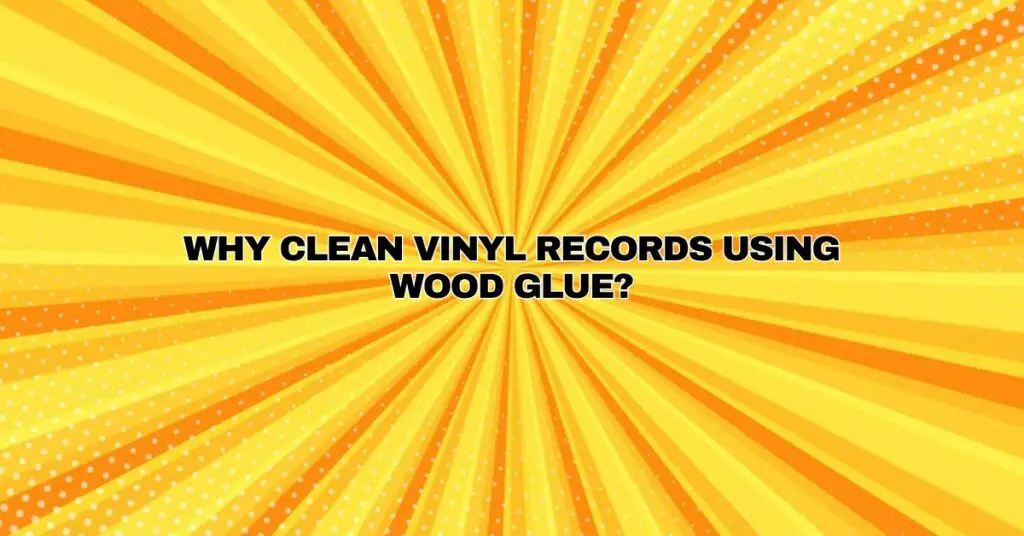Vinyl records, with their distinct analog warmth and immersive sound, continue to captivate the hearts of audiophiles and music enthusiasts around the world. Proper cleaning and maintenance of vinyl records are essential to ensure that they provide a high-quality listening experience and remain in excellent condition. While various methods and cleaning solutions are available, one unconventional technique that has gained attention in recent years is the wood glue method. In this comprehensive article, we will explore the wood glue method for cleaning vinyl records, its benefits, and the steps involved in this unique approach. Whether you are a seasoned vinyl collector or new to the world of analog audio, understanding the wood glue method can offer an alternative way to rejuvenate your vinyl collection.
1. The Importance of Vinyl Record Cleaning
Cleaning vinyl records is a fundamental aspect of vinyl record care, serving several crucial purposes:
- Dust and Debris Removal: Vinyl records inevitably accumulate dust, dirt, and microscopic particles, which can cause surface noise and affect sound quality.
- Static Reduction: Reducing static electricity helps prevent dust and debris from clinging to the record surface.
- Surface Cleaning: Removing fingerprints, oils, and smudges left by handling ensures that the stylus tracks smoothly.
2. The Wood Glue Method: How Does It Work?
The wood glue method, also known as the “Elmer’s Glue Method,” involves using a specific type of wood glue to clean vinyl records. Here’s an overview of how it works:
- Materials Needed: To perform the wood glue method, you will need high-quality white PVA wood glue (such as Elmer’s), a vinyl record brush, and a plastic spreader or card.
- Application: Spread a thin, even layer of wood glue onto the record’s surface, avoiding contact with the label in the center. Ensure that the glue covers the entire playable area.
- Drying: Allow the wood glue to dry completely, usually for a few hours or overnight. During the drying process, the glue encapsulates dust and debris, effectively lifting them from the record surface.
- Peeling: Once the glue is fully dry, carefully peel it off the record surface in one piece. The glue will have captured the contaminants, leaving the record clean.
- Cleaning Residue: After removing the glue, any residual adhesive can be cleaned with a gentle record cleaning solution and a soft brush or cloth.
3. Benefits of the Wood Glue Method
The wood glue method offers several advantages for cleaning vinyl records:
- Effective Dust Removal: The method excels at capturing and removing dust, dirt, and other particles from the record surface.
- Non-Abrasive: Unlike some cleaning methods that involve brushes or cloths, the wood glue method is non-abrasive and poses minimal risk to the record’s grooves.
- Affordability: Wood glue is an affordable and readily available cleaning solution.
- Restoration: The method can restore the playability and sound quality of heavily soiled or neglected records.
4. Limitations and Considerations
While the wood glue method can be highly effective, it’s essential to consider its limitations:
- Time-Consuming: The process requires patience, as both the application and drying of the glue take time.
- Not Suitable for All Records: Some records with damaged or peeling labels, or records that have been stored improperly with significant warping, may not be suitable for this method.
- Quality of Glue: High-quality PVA wood glue is recommended to ensure good results.
5. Conclusion
The wood glue method is an unconventional yet effective way to clean vinyl records, particularly those with stubborn dust and debris buildup. When performed correctly, it can restore the playability and sound quality of your records without damaging the grooves. While it may not be the fastest method, the wood glue technique offers an alternative approach to vinyl record cleaning that can be a valuable addition to your vinyl maintenance toolkit. However, always exercise care and caution when trying any new cleaning method to ensure the protection and preservation of your vinyl collection.


